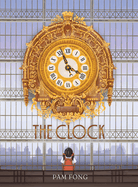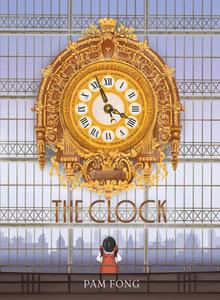
 Author/illustrator Pam Fong (The Little Cloud), who spent decades working in the art world, lets her background in and appreciation for art shine in The Clock, a distinctive and atmospheric narrative nonfiction picture book about the life of a grand clock in Paris, France.
Author/illustrator Pam Fong (The Little Cloud), who spent decades working in the art world, lets her background in and appreciation for art shine in The Clock, a distinctive and atmospheric narrative nonfiction picture book about the life of a grand clock in Paris, France.
Fong's title character begins its life in 1900 at the Gare d'Orsay where it "ticked to control the crisscrossing of trains" and "tocked to signal new opportunities." The clock kept the "station humming, and the world moving." But while the clock continues to tick and tock, the "fast-changing city outgrew the station." Paris abandons both, and the Gare d'Orsay stands dark and empty for decades. The clock "was abandoned.... But it was not forgotten." In 1986 the newly renovated building opens as a museum, the Musée d'Orsay, and the clock is again given a place of prominence. Now the "clock keeps a world-class art museum humming... and stops the world from moving."
Fong's text is concise and poetic, and she excludes details to maintain her economy of words. Instead, she uses backmatter to explain the names, dates, and locations shown in the book. Much like the inner workings of the clock itself, each piece of the book's design fits neatly within the whole and works seamlessly with the other components to make magic happen. From opening endpapers depicting the Orsay as a train station to closing endpapers, showing the Orsay as a museum, Fong's illustrations are clever, precise, and affecting. The inside of the groundbreaking steel and glass structure sparkles as diffused light shines through the windows, spotlighting the hustle and bustle of activity. The colors are crisp, the gold clock glitters, and the composition exudes constant movement. When the plot transitions to the abandoned station, Fong's palette gets hazy and dark, and images of broken windows and overall neglect create a powerful atmosphere of sadness. A view of the Eiffel Tower through shattered panes of glass is particularly effective in providing the reader with the clock's lonely perspective. A shining beam of light from a flashlight, though, pulls the clock out of the darkness, readying it for its new place in the spotlight.
The Clock is extensively researched, intricate, and a celebration of art in many forms; the simple text and detailed illustrations are likely to keep young audiences enthralled. --Jen Forbus, freelancer
Shelf Talker: In a stunningly illustrated children's picture book, a majestic clock tick tocks its way through the evolution of a Paris train station.

